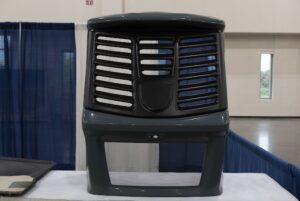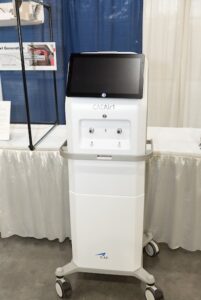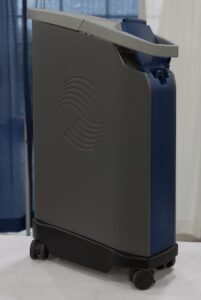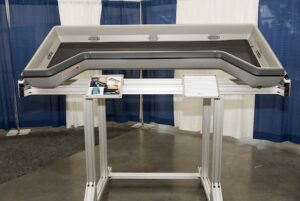
CAROL STREAM, IL, U.S.A., October 4, 2021 . . . The Society of Plastics Engineers (SPE) Thermoforming Division has announced the winners of its biennial parts competition.
The awards were presented during the Thermoforming Division’s conference, held September 20-22 in Grand Rapids, MI. This year’s winners are:
“People’s Choice.” Plastics Unlimited, for the “Hagie sprayer rear engine enclosure assembly.”
Vacuum Forming – Silver. Hammer Plastics, for the “Dashboard.”
Vacuum Forming – Gold. Plastique Art, for the “Ventilator.”
Pressure Forming – Silver. Profile Plastics, for the “Covers for automatic paint dispenser.”
Pressure Forming – Gold. Ray Products, for the “Multi-part medical cart.”
Twin Sheet – Silver. Penda, for the “Battery cell cover.”
Twin Sheet – Gold. Wilbert Plastics, for the “Over-the-road storage shelf for sleeper area.”
3D Printed Tooling – Silver. Plastics Unlimited, for the “Guard.”
3D Printed Tooling – Gold. Catalysis Additive Tooling, for the “Pallet.”
Parts Produced with Automation and New Technology – Silver. Plastics Unlimited, for the “Hagie sprayer read engine enclosure assembly.”
Parts Produced with Automation and New Technology – Gold. Hagans Plastics, for the “Chinook forward drip pan.”
“The pandemic had an unexpected effect on this year’s parts competition,” noted Travis Kieffer, 2021 SPE Thermoforming Parts Competition Chair. “The number of entries doubled from our last competition in 2019, and the parts were also really top-notch in quality. We received terrific support for our new category, Production Parts from 3D-Printed Tooling, and I can’t wait to see even more of those parts on display during the next SPE Thermoforming Parts Competition in 2023.”
PEOPLE’S CHOICE AWARD
Plastics Unlimited, Preston, IA Hagie Sprayer Rear Engine Enclosure Assembly
 Overview
Overview
This enclosure assembly houses a large, sophisticated medical treatment power supply.
Features and Benefits
All primary parts are twin sheet formed to provide a highly aesthetic, structurally rigid assembly for the enclosure.
Material is custom color pearlescent metallic, formed on a smooth toolsurface to yield a high gloss appearance for the multipart assembly and is formed from an Acrylic-PVC blend.
The innovative design provides formed-in threaded inserts to receive quarter turn fasteners, allowing for easy, quick, and simple assembly by the OEM.
The large 4’x4’ advanced twin sheet upper cover contains two 10” fan attachments providing ventilation control and noise reduction through the integrated hollow-part design while simultaneously maintaining the very high aesthetic requirements.
The innovative utilization of the undercut on the inside of the door provides an easy- to-use handle and formed-in hinge receiving pads with precise alignment, quick assembly and mounting features, making the device user friendly and easy to remove/replace by a single service manager.
Lower twin sheet skirts utilize form-in plastic attachment features for immediate drop-in attachment eliminating the need for mechanical fasteners.
Overall assembly time reduced OEM man hours by 75%.
VACUUM FORMING – SILVER
 Hammer Plastics, Mishawaka, IN Dashboard
Hammer Plastics, Mishawaka, IN Dashboard
Overview
This is a dash assembly for Class A motorhomes.
Features and Benefits
Base is a custom color Low Gloss ABS. Decorative film is a selected brush aluminum with a polyurethane cap gloss surface.
Additional Information
Tooling layout and design accommodates for differentiation in shrink factors for the various components. Shipped as a complete assembly as presented.
VACUUM FORMING – GOLD
Plastique Art, Sainte-Claire, Quebec, Canada Ventilator
 Overview
Overview
This enclosure assembly of eight thermoformed parts houses a high-end intensive care unit ventilator. In response to the COVID-19 pandemic, our customer was awarded a contract of10,000 units to be manufactured urgently.
Features and Benefits
In order to meet the extraordinary challenge of designing and manufacturing an enclosure for a brand-new ventilator in only three weeks with the intention to be production ready after approval, all parts were vacuum formed to provide the best aesthetic and functionality within this short time frame.
The other components of the device being developed simultaneously, daily collaboration with the OEM and designer was required to make recommendations and adjustments while keeping the same deadline. Our focus was to optimize the design for manufacturability while achieving the best fit of the parts, knowing that they had to be thermoformed on male urethane molds which would be then utilized also for production.
The capacity of the supplier to deliver custom color sheets for prototypes under a week and on short notice for mass production was critical to the success of this project.
Assembly of the enclosure has been designed to minimize the attachment points. First, to reduce the time required for the OEM, but also to limit the contact points with the metallic substructure and avoid interferences that should come from unknown tolerance stack-up of all the other components.
By making the tools in-house with a staff fully dedicated to this project, we were able to meet the 10 days lead time for 11 devices ready for certification by a health agency.
Upon final approval of the device, we needed to ramp up the production quickly to make 10,000 devices in under 16 weeks. For this, multi-cavity, temperature controlled, aluminum moulds were required for all parts. Even though they were made quickly, in the meantime we still had to make around 2,000 parts out of urethane tools and maintain consistency throughout the program.
PRESSURE FORMING – SILVER
 Profile Plastics, Lake Bluff, IL Covers for Automatic Paint Dispenser
Profile Plastics, Lake Bluff, IL Covers for Automatic Paint Dispenser
Overview
This is a two-part project that meets the target price points of the customer and serves as a durable yet easily removable cosmetic cover for an automatic paint dispenser.
Features
Tooling: Two machined aluminum tools, water cooled, acid etched texture
How did this part provide a solution? The customer was highly price-sensitive yet wanted to meet functional, cosmetic, field service and durability requirements. The final two-part solution met the desired specifications.
Primary challenges:
1) Designing a durable, yet easily removable part: For servicing the underlying equipment, the customer wanted a rigid yet highly cosmetic assembly that could also be removed easily by service technicians without being damaged.
Solution: Through extensive DFM collaboration with the customer’s design team, we arrived at a cover system that can be conveniently taken off and easily put back on securely. This includes hidden fastening points to the frame.
2) Achieving desired thickness with minimum material: The deeper part geometry combined with the customer’s cost constraints demanded working with a minimal starting gauge.
Solution: We developed the necessary processes to achieve the part cost requirements without sacrificing part rigidity and performance that the customer required out in the field. Several gauge and process trials were undertaken to realize this goal.
3) Surface Durability: The part needed to be able to withstand an environment in which excess paint from use needs to be removed with harsh cleaning agents.
Solution: Color-matched material was selected to eliminate the need for a painted finish on the part, which may have been damaged from normal use in the field.
PRESSURE FORMING – GOLD
 Ray Products, Ontario, CA Multi-Part Medical Cart
Ray Products, Ontario, CA Multi-Part Medical Cart
Overview
This multi-part medical cart includes 12 highly-aesthetic and repeatable pressure formed parts. The assembly includes a combination of molded-in color and painted parts. With the cart originally manufactured using the urethane cast process, pressure forming was able to improve part-to-part repeatability and aesthetics without impacting the overall design of the cart.
Features and Benefits
This cart was previously manufactured using urethane casting which required painting every part and limited the production quantities to 25 pieces at a time. The urethane parts also required a 100% inspection using a full assembly check fixture and approved parts being kitted and shipped together as a unique set.
After switching to pressure forming, the medical device manufacturer was able to significantly reduce total project costs, improve their manufacturing speed, increase part durability, and was guaranteed part-to-part repeatability without the need of unique sets. The pressure forming process provided the customer with a total return on investment within the first 50 units produced, and additionally, had no issues meeting current and future customer demand.
By manufacturing the unit with the pressure forming process and using various molded-in features, including several undercuts, we were able to significantly reduce the number of purchased components that were needed to mount the urethane parts. This allowed for a significant reduction in total assembly time by our medical customer along with maintaining the tight tolerances they required.
TWIN SHEET – SILVER
 TriEnda Holdings, Portage, WI Battery Cell Cover
TriEnda Holdings, Portage, WI Battery Cell Cover
Overview
This assembly secures the inner trays filled with fragile lithium-ion batteries.
Features and Benefits
Both the top and bottom clam shell pieces are twin sheet thermoformed components that are durable, yet light weight compared to prior wooden solutions.
Material is HDPE, .500 gauge formed on smooth tool surfaces with varying sheet starting gauges and different tool depths between the base and top. Two aluminum production tools ran concurrently, forming one full pack with each cycle. A total solution using additional materials and processes such as EEP foam and injection molded ABS trays.
The critical design requirements achieved include a longer lasting, impact absorbing, product protection from damage and short circuiting, pack weight reduction, and elimination of expendable packaging requiring special fillers in case of damage. Tested to DOT and UN standards for over the road and airfreight, success was achieved by the durability and flexibility of the outer shell in HDPE.
Current practice is shipping from overseas to the US in wooden crates that were used for one or two shipments. This solution is able to be utilized in many more return shipments, is fully recycle-able, and is accessible to be used with both OEM robotics and manual handling as needed.
TWIN SHEET – GOLD

Wilbert Plastics, White Bear Lake, MN Over-the-Road Storage Shelf for Sleeper Area
Overview
Part is a storage shelf for the sleeper area of an over-the-road truck cab which was manufactured using the twin sheet process and completed using internal foam, hardware assembly, and electrical wiring.
Features and Benefits
Shelf body is formed using the twin sheet thermoforming process.
Mold surfaces are engraved with two different textures to create the customer’s styling needs.
Shelf body is then edge trimmed along with mounting bracket openings, and then brackets and internal plates for structure are installed prior to foaming.
Low-pressure, two-part foam is added to fill the inner cavity of the Shelf to add structure. Mounting bracket locations are also confirmed at this stage.
Tie down bracket holes, wiring openings, and pockets for the switch and lights are then trimmed in a robotic cell.
Final assembly involves installation of tie down brackets, wiring of lights, power input and switch, surface mat, and then prepared for safe shipment.
Result
A structurally sound, aesthetically looking storage shelf that the customer can use as an option to replace the upper sleeping bunk in an over-the-road truck cab.
3D PRINTED TOOLING – SILVER

Plastics Unlimited, Preston, IA Guard
Overview
This enclosure assembly houses a large, sophisticated medical treatment power supply.
Features and Benefits
All primary parts are twin sheet formed to provide a highly aesthetic, structurally rigid assembly for the enclosure.
Material is custom color pearlescent metallic, formed on a smooth tool surface to yield a high gloss appearance for the multipart assembly and is formed from an Acrylic-PVC blend.
The innovative design provides formed-in threaded inserts to receive quarter turn fasteners, allowing for easy, quick, and simple assembly by the OEM.
The large 4’X4’ advanced twin sheet, upper cover contains two 10” fan attachments providing ventilation control and noise reduction, through the integrated hollow-part design, while simultaneously maintaining the very high aesthetic requirements.
The innovative utilization of the undercut on the inside of door provides an easy- to-use handle and formed-in hinge receiving pads, with precise alignment, quick assembly, mounting features, making the device user friendly and easy to remove/replace by a single service manager.
Lower twin sheet skirts; utilize form-in plastic attachment features for immediate drop-in attachment eliminating need for mechanical fasteners.
Overall assembly time reduced OEM man-hours by 75%.
3D PRINTED TOOLING – GOLD

Catalysis Additive Tooling, Columbus, OH Pallet
Overview
This 3D printed thermoforming production tool was used to form pallets, utilizing binder jet technology. The material formed over the tool was 0.250” HDPE for 1,000+ parts.
Features and Benefits
This tool provides many benefits over traditional metal tooling.
A one-two week manufacturing time offers faster manufacturing time, getting the tool into the hands of customers twice as fast as a machined metal tool.
This tool is half the price of a traditional metal tool. When creating a tool using additive manufacturing, complexity isn’t dependent on machine time like typical subtractive manufacturing.
This tool is 100% porous, allowing the tool to pull a more consistent vacuum on the part. This tool manages to be porous, while also having a 100 Ra surface finish. The combination of the two make for a clean, well-formed part. The addition of blowoff holes in areas with a little amount of draft ensures the part comes off smoothly without damage to the tool or part.
The innovative design on the underside of this tool utilizes the full capabilities of 3D printing for thermal management and strength of the tool. On a shuttle system, this tool can maintain a consistent 170 °F.
The underside also doubles as a vacuum chamber. When paired with the porosity of the tool, a near-perfect pull on the material is possible.
This tool is able to withstand thousands of parts. This means that the longevity of a tool isn’t dependent on price and lead time, which is the major drawback of other tooling materials such as wood and plastics.
Takeaways
Half the cost, half the time; 100% porous; able to pull thousands of parts; maintains consistent tool temp.
PARTS PRODUCED WITH AUTOMATION AND NEW TECHNOLOGY – GOLD
 Hagans Plastics, Grand Prairie, TX Chinook Forward Drip Pan
Hagans Plastics, Grand Prairie, TX Chinook Forward Drip Pan
Overview
This part replaces an aluminum pan due to both increased strength and weight reduction.
Features and Benefits
This part is made using oil temperature-controlled match metal aluminum tooling. The material is a PEEK/Kevlar non-woven fiber that must be formed in excess of 500 degrees. This panel was redesigned to include more head room for the navigator. Issues that were occurring included the current aluminum pan causing holes to appear in the helicopter skin caused by vibration. The time it took to change out the current pan due to the ridged structure was reduced in half with the new design and material selected.
The new material is able to be formed in a multitude of ways and thicknesses. It can maintain a ridged perimeter while still having some flexibility throughout the center section of the part. This material is completely resistant to all types of POL, (Petroleum, Oils, Lubricants) after forming. The material throughout the testing phase was not adversely affected by the high degree of vibration that occurs in helicopters. It also provided the strength needed for additional mounting points and quarter turn fasteners to be attached. In addition, the weight reduction of this new part was over four pounds versus the previous aluminum part.
Prior to this project, the material had not been tested for forming. We developed the process through many trials.
This has now been approved to be included in all new Chinook Helicopters manufactured by Boeing and spares for existing helicopters currently in use.
THE SPE THERMOFORMING DIVISION is a technical chapter of the Society of Plastics Engineers, based in Danbury, CT. The Thermoforming Division’s mission is to facilitate the advancement of thermoforming technologies through education, application, promotion and research. The Division hosts an annual educational conference and publishes an award-winning technical journal, SPE Thermoforming Quarterlyâ. The Division has also funded over $275K in equipment grants and tens of thousands of dollars in undergraduate scholarships since it was first formed. For more information, please visit https://thermoformingdivision.com.